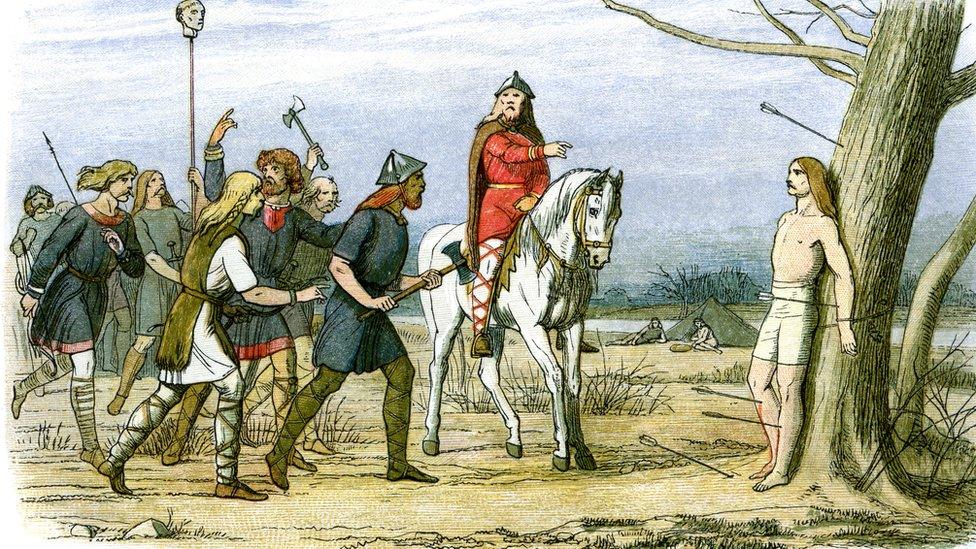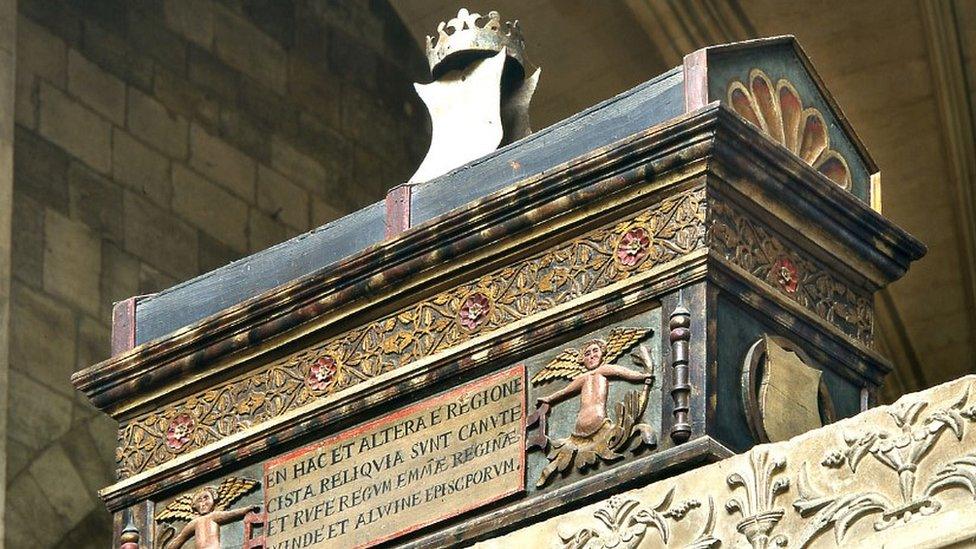Sweyn Forkbeard: The legend of the Viking king 'killed by a ghost'
- Published

Legend has it Sweyn Forkbeard was killed by the ghost of St Edmund
Forty days after he was crowned king of England, Sweyn Forkbeard was apparently murdered in his bed. The weapon was allegedly a spear. But the killer? Folklore has it as the ghost of St Edmund, seeking revenge for his own death at the hands of the monarch's Viking predecessors. Is there any truth to the legend?
As improbable as it might sound, Darron Childs believes there is.
The historian, who has spent more than 30 years researching Gainsborough's Viking history and is due to publish his latest research in his book, Touched by the Hand of Christ, believes politics and taxes both played a part in Forkbeard's downfall. But it was perhaps ignoring the warning of a monk that truly sealed his fate.
Forkbeard had, in his short time on the throne, demanded taxes be paid across the realm, Childs explained, including from those under the patronage of St Edmund, who had previously enjoyed exemption.
If they were not paid promptly, Forkbeard threatened that Bury St Edmunds (or Boedericsworth, as it was then known) would be set on fire and the priests put to death.
St Edmund allegedly visited the keeper of his relics as he prayed, a monk called Ailwin who believed the taxes to be unjust, and gave him a message: "Ask [Forkbeard], in my name why do you tax the people who pay tribute to none but me?"
In another account by Richard of Cirencester, a 14th Century monk at Westminster Abbey, Ailwin was told to deliver the warning to Forkbeard: "Desist from his oppressions and exactions on his people if he would avoid divine vengeance hanging over his head".

Forkbeard ruled England for just 40 days
When Ailwin told the royal court what he had seen and heard, he was "unceremoniously ejected", just in time for the feast of Candlemas to commence, Childs said.
Later, a drunken Forkbeard retiring from the festivities, was said to cry out: "Help me my soldiers, help me. Behold, St Edmund comes to kill me."
"This is where the whole story then starts to make some sense that Forkbeard was murdered by the mysterious ghost of St Edmund," suggested Childs.
To understand the reasons behind the murder in February 1014, we need to know something of the political and royal history of England at the time.
Sweyn Forkbeard had been crowned on Christmas Day the year before, having deposed his own father, Harald Bluetooth, the first Christian king of Denmark.
A fierce warrior, his campaigns against the English began with raids and skirmishes but developed into a full-scale military operation with the objective of seizing power from King Ethelred II, who had ordered the slaughter of all Danes living in England in 1002 in what became known as the St Brice's Day massacre.
This prompted a "campaign of terror" from Forkbeard's armies, said Childs, with a large-scale invasion finally proving decisive, and Ethelred fleeing to France.

The king died at the the site of what is now Gainsborough Old Hall. His royal court was based in the town.
As well as making his name in battle, Forkbeard recognised the importance of securing political alliances and arranged for his son Canute to marry Aelfgifu, the daughter of a prominent Mercian family.
Soon after their marriage in Gainsborough, the capital of England at the time, Forkbeard allegedly accused Aelfgifu of treachery, Childs said.
"She was terrified of these accusations and the prospect that this could lead to the murder of her family members.
"It is possible that she was also afraid that her marriage to Canute could be sidelined in favour of someone, or something, that offered greater political advantage."
Although it is an "amazing" theory, Aelfgifu had a motive, suggested Childs, and the warning from Ailwin provided a convenient alibi.
"It meant Forkbeard could be sent to meet his maker, and any blame conveniently apportioned to St Edmund, the dead king and martyr."

Edmund was venerated as a martyr saint soon after his death at the hands of Danish Vikings
However, Chris Tuckley, head of interpretation and learning at York Archaeology, is less convinced, suggesting that the story was a convenient way of venerating St Edmund, who was killed by Viking raiders in AD869 when he refused to turn away from Christianity.
"The account of the killing of Sweyn by St Edmund seems to me in keeping with other medieval hagiographical traditions, bolstering the reputation of a saint by claiming that an insult or blasphemy has led to a horrid end for some powerful villain or another."
He added: "The Anglo-Saxon Chronicles, which as far as we know don't conceal murders when they have happened, have very little to say on the matter of [Forkbeard's] death."

Childs says Ailwin's warning may have provided an opportunity and alibi for some within his own court, including Aelfgifu, pictured here with Canute
Aelfgifu's part in the murder has never been proven.
She was later sent to Norway to rule for Canute, who was crowned king of England after the death of Ethelred in 1016, and was "most certainly a force to be reckoned with", said author and historian Annie Whitehead.
However, she suggests Aelfgifu had little to gain from killing Forkbeard.
"[Aelfgifu's] family was accused of disloyalty by the English king precisely because of their support for Sweyn.
"Her father lost his life because of it," she added, referring to Aelfhelm, ealdorman of Northumbria, who was killed in 1006.

It is said Forkbeard's remains were taken to Denmark and buried on the site of an old wooden church in the grounds of what is now Roskilde Cathedral
In the same way that Forkbeard's killer remains a mystery, so does the location of his body.
Canute ordered Aelfgifu to take his father's corpse back to Denmark as he feared it would be desecrated or lead to retribution, Childs said.
It is said his remains were taken to Roskilde and buried on the site of an old wooden church, though there is also a modern theory that his remains may have been buried in Lund, now part of Sweden.
Laura Maria Schütze, researcher at Roskilde Museum/University of Copenhagen, said the burial place is still "shrouded in mystery".
What she does suggest, however, is that Forkbeard likely died from "old age or illness", particularly as he had instructed Canute where he wanted to be buried.
"We don't know the birth year of Sweyn but he was king from 987, perhaps even earlier, and there is a total of him ruling for 27 years."
She said work is due to start next year to establish who built the wooden church on the site where Roskilde Cathedral stands today.
"Was it Bluetooth or Sweyn himself, which indirectly would place his tomb in Roskilde?" she asks.
Childs is planning a commemorative event in Gainsborough in February to mark the life, and death, of the first Viking king of England.
Despite his short reign, Childs says Forkbeard left a lasting legacy and paved the way for his son Canute to become the "most powerful ruler of his age" - earning him the title of the Great.
Regardless of who or what killed him, it is "a story that deserves to be told", he added.

Follow BBC East Yorkshire and Lincolnshire on Facebook, external, X (formerly Twitter), external, and Instagram, external. Send your story ideas to yorkslincs.news@bbc.co.uk, external
Related topics
- Published21 November 2022

- Published16 May 2019

- Published25 December 2013
